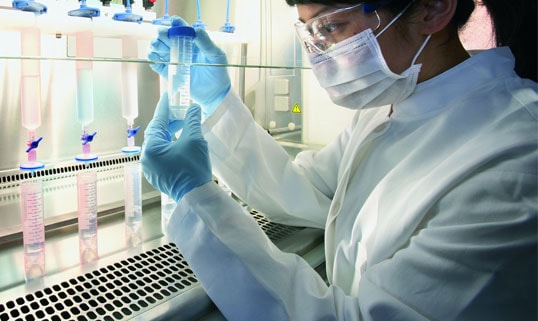Hepa1-6-iRFP-Puro
- Frozen / Standard (CL131-STAN) $ 1,500
Species: Mouse
Cell type: C57/L hepatoma
Transgenes: Near-infrared fluorescent protein (iRFP; ex/em = 690/713) with puromycin resistance (Puro) for selection with puromycin.
Media: DMEM, 10% FBS, 1% Pen/Strep, 2 μg/mL puromycin
Description: Hepa1-6-iRFP-Puro is a polyclonal population derived from the hepatoma Hepa 1-6 cell line (ATCC® CRL-1830TM) transduced with a lentiviral vector LV-iRFP-P2A-Puro (LV032) encoding the near-infrared fluorescent protein (iRFP) cDNA under the SFFV promoter linked to the puromycin resistance gene (Puro) via a P2A cleavage peptide.
The lentiviral vector used is a self-inactivating (SIN) vector in which the viral enhancer and promoter have been deleted. Transcription inactivation of the LTR in the SIN provirus increases biosafety by preventing mobilization by replication competent viruses and enables regulated expression of the genes from the internal promoters without cis-acting effects of the LTR (Miyoshi et al., J Virol. 1998).
Mycoplasma Testing: The Hepa1-6-iRFP-Puro cell line has been tested for mycoplasma contamination and is certified mycoplasma free.
Cell Line Authentication: The Hepa1-6 cell line was authenticated and certified free of interspecies cross-contamination by short tandem repeat (STR) profiling.
Recommended uses:
In vitro: This is a high iRFP expressing cell line suitable for use as a positive control cell line in fluorescence assays to verify iRFP expression in lentiviral transduced cells.
In vivo: Hepa1-6 cells form primary tumors and spontaneous lung metastases post implantation into syngenic C57L/J mice. The iRFP transgene facilitates in vivo noninvasive fluorescence imaging of implanted cells. iRFP is immunogenic and may cause tumor rejection in immunocompetent mice. For the most consistent results, immunocompromised mice are recommended for studies. To reduce background autofluorescence, mice should be fed an alfalfa-free diet for at least a week prior to imaging.
Note: Please ensure that your optical imaging system has the appropriate filter sets for imaging iRFP (iRFP; ex/em = 690/713)
Morphology: Low- and high-density cell morphology (200x)

Flow Cytometry for iRFP: Hepa1-6-iRFP-Puro (red) or control (Hepa1-6; grey) cells were fixed with paraformaldehyde and analyzed by flow cytometry.


